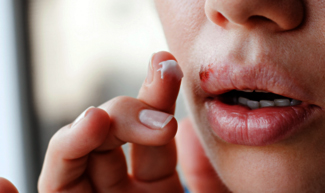Herpes Viruses – unpredictable and dangerous

When it comes to herpes simplex viruses, circumstances determine whether they remain harmless or become unpleasant, or even life-threatening. Experts from the Medical Center - University of Freiburg explain what these circumstances are and how to protect yourself against the attacks.
Unfortunately, there is one thing one has to be prepared for: it is hard to escape the herpes simplex virus in the long run - unless one is very lucky. Most people have contracted the virus by the time they reach retirement age at the latest. Many are unaware of it because the virus first multiplies unnoticed and then withdraws into the nerve cells, where it begins to lie dormant. In other people, however, it causes severe inflammation - and does so regularly every time the virus wakes up in the nerve cells. An increasing number of people in Germany are also becoming infected for the first time not via saliva and the mouth, as most do, but the virus enters their body via the genital area. "This route of infection is often associated with particularly unpleasant and persistent symptoms," says Prof. Dr. Hartmut Hengel, Medical Director of the Institute for Virology at the Medical Center - University of Freiburg. Symptoms include a painful rash and fever.
Decisive factor: the age of first contact
It has not yet been fully understood why people experience an infection with the herpes simplex virus 1, HSV-1 for short, so differently. However, there is some evidence to suggest that an important factor is the age of first contact with the pathogen. In children, this often goes unnoticed. After transmission, the pathogen multiplies in the oral mucosa and then climbs along the nerve pathways to nodes such as the trigeminal ganglion. It nests in the nerve cells connected there because the defense cells there cannot harm it.
An often unpleasant infection, especially for adults
However, a growing proportion of people do not become infected until adulthood, and often experience the first contact as extremely unpleasant. This is because the multiplication in the oral mucosa is not seldom accompanied by symptoms. First symptoms are non-specific: a burning, tingling or stinging sensation around the mouth. Then the typical cold sores form in the lip area, sometimes also in the mouth or on the tongue. Some people also have a fever and swollen lymph nodes.
More and more people infected during sexual intercourse
Such late infection is increasingly common during sexual intercourse. HSV-1 infects the mucous membrane of the vagina, penis or anus. "We suspect that this is due to the fact that transmission becomes less frequent in childhood," says Professor Hengel. For this reason, many adults do not yet have immune protection against herpes viruses during their first intimate contacts, which prevents the pathogens from infecting the genital area if they have sexual intercourse with an infected person. Herpes simplex virus type 2, a close relative of HSV-1, causes very similar symptoms. It is also not yet clear why fewer and fewer children are becoming infected: one possible reason could be the improved hygiene conditions in households and the fact that the average number of children per family is decreasing. Both of these factors make it more difficult for the pathogen to spread.
The Institute for Virology at the Medical Center - University of Freiburg is considered to be particularly experienced and has therefore been commissioned as a consulting laboratory for herpes simplex viruses in Germany. The Freiburg doctors and scientists advise medical and scientific colleagues on diagnostics and therapy. As part of their research, they also deal with other subspecies of the herpes virus family that can cause problems in humans: in addition to herpes simplex, the best known are the varicella zoster virus and the cytomegalovirus.
When immune cells weaken, HSV takes advantage
Stress, colds and fever awaken the pathogen. Phases in which the immune cells weaken are used by the pathogen to migrate again in the nerve tracts and then - usually on the edge of the lip, in other people in the nose or in the eye - cause the burning blisters.
After a week to ten days, the symptoms usually disappear on their own. "The most common reasons for such a flare-up are prolonged stress, colds, lack of sleep, fever or the onset of menstruation," says Dr. Daniela Huzly, senior physician and head of diagnostics at the Institute for Virology at the Medical Center - University of Freiburg. This is because such influences activate the virus genes and distract the immune cells that otherwise keep the virus under control.
Drugs such as cortisone, which also promote herpes outbreaks, have a similar effect. In some cases, however, local influences such as high doses of sunlight or UV light are enough to cause blisters to appear. For people with an extremely weakened immune system or for newborns with an immature immune system, herpes simplex 1 can even be life-threatening: Under these circumstances, the virus can trigger brain inflammation, sepsis or liver inflammation.
Basic rule of therapy: start early
Avoiding and reducing stress, for example through relaxation exercises, counteracts this. Good sun protection in sensitive areas can also help prevent herpes attacks. Lip balms make the skin on the lips more resistant. "If you repeatedly experience the symptoms as very unpleasant, I would also recommend the use of antiviral agents such as acyclovir as an ointment or tablet," Prof. Dr. Hartmut Hengel advises. Important to note: The multiplication of HSV-1 can best be inhibited if these agents are applied as soon the first tingling or burning sensation occurs and therefore before the blisters appear. Cooling open skin areas with ice cubes, anti-inflammatory medication such as ibuprofen or local anesthetics have also proven to be helpful against the symptoms. And of course, if the blisters are sprouting, kissing is prohibited - or at least caution is advised when coming into contact with non-infected people.
Back